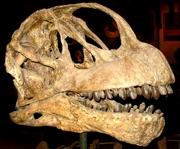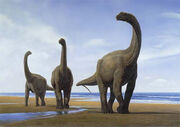| Camarasaurus | |
|---|---|

| |
| A restoration of Camarasaurus supremus | |
| Scientific classification | |
| Kingdom: | Animalia |
| Phylum: | Chordata |
| clade: | Dinosauria |
| Order: | Saurischia |
| Suborder: | †Sauropodomorpha |
| Family: | †Camarasauridae |
| Subfamily: | †Camarasaurinae Cope, 1878 |
| Genus: | †Camarasaurus Cope, 1877 |
| Type species | |
| †Camarasaurus supremus Cope, 1877 | |
| Referred species | |
| |
| Synonyms | |
| |
Camarasaurus (ca·mar·a·saur·us) was probably the most common sauropod dinosaur of the Late Jurassic Morrison Formation in North America. This large, 25-ton plant-eater was strong and massive, with powerful legs, a strong neck and tail, and a rounded head. Deep pockets or chambers in the vertebrae (bones of the spine) of camarasaurus lightned skeleton without giving up strength. It is also how the dinosaur got its name, which means "chambered reptile."
Description

Camarasaurus' teeth, which are different than other sauropods
The most unusual features of Camarasaurus were on its head. The large jaw bones had strong jaw muscles, and the teeth were unusually large for a sauropod. They were as large as chisels, with sharp points that chopped the plants it ate. Camarasaurus probably fed on plants that were coarse and tought. Its relatives Apatosaurus and Diplodocus, with their small weak teeth, probably ate soft, tender plants.With large eyes and nostrils, Camarasaurus was alert and active. Like other sauropods, it probably moved in herds. It lived in the arid and semi-arid open country of North America. One Camarasaurus pelvis from the Cleveland-Lloyd Dinosaur Quarry in Utah has huge grooves in the bones where an Allosaurus tore into the flese and gouged the bones. Allosaurus was its fiercest enemy, but and adult Camarasaurus was so much larger that it was seldom attacked. A complete skeleton of a juvenile Camarasaurus was excavated from Dinosaur National Monument in Utah. Such skeletons are rare. Perhaps young sauropods grew to adult size quickly, so there is little chance of finding them in the fossil record.One interesting twist of fate for Camarasaurus was that its head was mistakenly placed on the skeleton of Apatosaurus at the Carnegie museum of Natural History. The mistake was not fixed for 75 years.
Paleobiology

A Camarasaurus herd
There is a fossil record of two adults and a 12.2 meter long juvenile that died together in the Late Jurassic Period, (excavated in north east Wyoming, USA, by the Division of Vertebrate Paleontology of the University of Kansas Natural History Museum and Biodiversity Center, during the 1997 and 1998 'field seasons'). It is assumed that their bodies were washed to their final resting place, in alluvial mud, by a river in spate. This suggests that Camarasaurus traveled in herds or, at least, 'family' groups. Also, recovered camarasaurus eggs have been found in lines, rather than in neatly arranged nests as with some other dinosaurs, which appears to suggest that, like most sauropods, Camarasaurus did not end its young. As for its digestion, some scientists had suggested that Camarasaurus and other sauropods may have swallowed stones to help grind the food in the stomach and then regurgitated or passed them when they became too smooth. However, more recent analysis of the evidence for stomach stones has suggested that this was not the case. Furthermore, the strong, robust teeth of Camarasaurus in particular were more developed than those of most sauropods, indicating that it may have processed food in its mouth to some degree before swallowing.
References
1. Host site of picture [1]
2.Information Credits to "ROMTECH" Computer CD Dinosaur Discovery